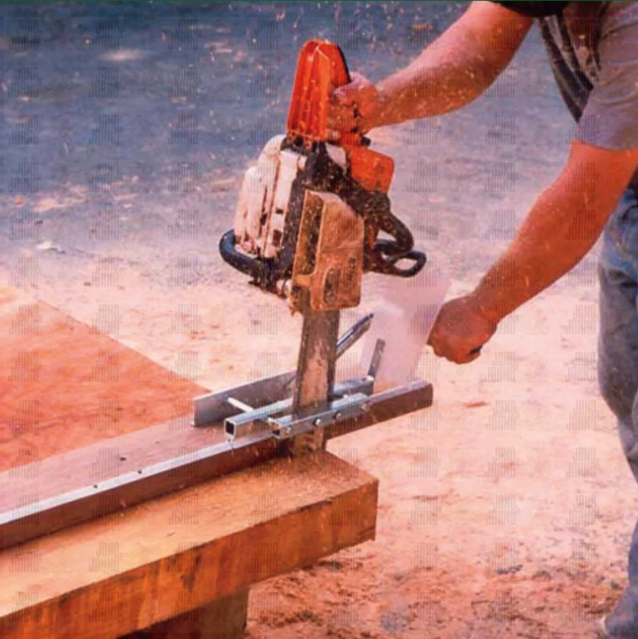What to Do When Your Chainsaw Cuts Crooked
A chainsaw is a powerful and potentially dangerous tool that requires proper maintenance to ensure safe and effective use. If it’s not well cared for, it can lead to serious accidents or poor performance. For example, if the chainsaw sputters at an inopportune moment, it could throw off your cut, cause a branch to snap unexpectedly, or even get stuck in the tree. Your chainsaw should cut straight and true. If it starts to curve or cut unevenly, it's a sign that something might be wrong. A chainsaw sharpener might be needed, or you may need to replace the cutting teeth entirely. Here’s what you can do if your chainsaw isn’t cutting straight. There are many reasons why a chainsaw might start cutting crooked. It could be due to a dull chain, uneven top plates, damaged cutting teeth, or improper tension. Sometimes it's simply a matter of how you're using the tool. The chain is the main cutting component of your chainsaw. If it's not sharpened evenly, or if it becomes dull, it will struggle to make clean, straight cuts. This is especially true when working with hard wood or large branches. Using a high-quality chain like a Stihl model can help maintain better performance over time and reduce the frequency of sharpening. Chain tension is crucial for both performance and safety. If the chain is too tight, it can put extra strain on the motor and cause damage. If it's too loose, it may come off the bar or cause injury during operation. The top plate of each cutter is responsible for making contact with the material being cut. If these are uneven, the chain won't cut smoothly, leading to crooked results. A worn or damaged bar can significantly impact the performance of your chainsaw. It supports the chain and helps guide it as it cuts. If the bar is not in good condition, it will affect the quality of your cuts and increase wear on the chain. Even if you know how to sharpen a chainsaw chain, some teeth may have been damaged from cutting through dirt, rocks, or other hard objects. This can result in uneven cuts and reduced performance. An improperly set depth gauge can also lead to inconsistent cuts. The depth gauge controls how deep the chain cuts into the wood. Over time, as the chain wears down, you'll need to adjust this to maintain optimal performance. If your chainsaw is cutting unevenly, it might be time to sharpen the chain. Here are the steps to do it right and keep your saw performing at its best. Before sharpening, make sure the chain is clean and free of dirt, oil, or debris. This makes the sharpening process easier and more accurate. Soak the chain in a solution of water and ammonia to remove any buildup, then rinse and dry it before proceeding. Set the chain tension so it’s just snug but not too tight. A properly tensioned chain ensures smooth cutting and reduces the risk of it coming off during use. Begin by sharpening the shortest cutter first. This ensures all teeth are the same length. Once they’re even, the chain will cut straighter and more efficiently. Hold the file at the correct angle—usually around 30 degrees. This allows the blade to cut effectively without damaging the tooth. After sharpening one side, flip the chainsaw and repeat the process on the opposite side. Make sure every tooth is filed evenly for consistent cutting performance. Finally, check the depth gauges. They should be slightly shorter than the cutting teeth. If they’re too long, they’ll prevent the chain from cutting properly and may need filing down. A chainsaw that cuts in a zigzag pattern is not only inefficient but also dangerous. Using a professional chainsaw sharpener can help ensure that your equipment performs reliably and safely. Always remember to maintain other parts of your chainsaw as well, such as the bar and chain tension. At Jono & Johno, we offer everything you need for chainsaw maintenance, including high-quality chains, power tools, and safety gear. Visit our website to browse our full range and reach out with any questions. We're here to help you stay safe and productive in the field. Leak Testing Equipment,Quality Control Leak Testing,Leakage Detection Machinery Sentis Equipment Co.,Ltd , https://www.spemachine.com
Why Your Chainsaw Cuts Crooked
Uneven Chain Sharpness or Dull Chain
Incorrect Chain Tension
Uneven Top Plates
Worn Out Chainsaw Bar
Damaged Cutting Teeth
Improper Depth Gauge
How to Sharpen a Chainsaw Chain Properly
Step 1: Clean the Chain
Step 2: Adjust Chain Tension
Step 3: Start with the Shortest Cutter
Step 4: File at the Correct Angle
Step 5: Sharpen All Cutters Evenly
Step 6: Check Depth Gauges
Get Professional Chainsaw Sharpeners at Jono & Johno
